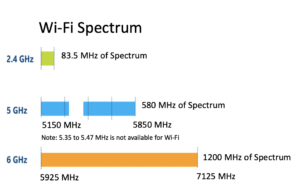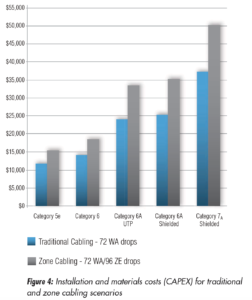In the 20 years since Wi-Fi first emerged, it has rapidly reshaped the networking world. It is now the primary method for data access in enterprise and residential applications worldwide. Because of the huge success of Wi-Fi, there is no longer a requirement to pull copper cable to every desktop which fundamentally changes the nature of in-building networking. Wi-Fi will soon be joined by private 5G cellular networks that run in the CBRS band (in the U.S.) and will greatly improve in-building cellular service. CBRS uses a very special licensing regime that allows the enterprise to easily acquire the needed spectrum. The move to the all-wireless enterprise is well underway, but its success depends on spectrum.
The FCC has been hard at work opening up new spectrum for both licensed and unlicensed use. Their latest effort involves spectrum sharing in the band between 5.925 – 7.125 GHz. This represents 1.2 GHz of spectrum and the IEEE has wasted no time extending 802.11ax (aka Wi-Fi 6) to operate in the 6 GHz band. This extension is now known as Wi-Fi 6E and merchant silicon is on its way. Note: Wi-Fi 6 and 6E are certification programs within the Wi-Fi Alliance.

The emergence of Wi-Fi 6 and 6E and the opening up of 1.2 GHz of new spectrum is creating a wireless perfect storm. The tremendous throughput of this technology, approaching 10 Gbps (theoretical), is made possible by using 160 MHz wide channels, advanced beamforming techniques, and multi-user MIMO (aka spatial multiplexing). The latter enables a single access point to communicate with as many as 8 users at the SAME time over the SAME RF channel. Each of these data streams can approach 1 Gbps, which means a 30,000 square feet office building with 150 heavy data users can easily be supported with half a dozen Wi-Fi 6E Access Points, and with 7 non-overlapping 160 MHz channels in the 6 GHz band, there is no meaningful interference. This fundamentally changes the nature of enterprise in-building networking. No more having to pull wire to every desktop, now it’s about connecting a handful of broadband access points back to the wiring closet.
So, what is the optimum way to backhaul Wi-Fi 6/6E and private 5G cellular access points?
One option is to use shielded CAT6A cable with a solid core and a plenum rating. This is more expensive, thicker, and harder to pull than CAT5, but it can deliver the throughput required for Wi-Fi 6 and 6E AP’s and it can support PoE (power-over-Ethernet) at distances up to 100 meters. As a result, CAT6A has become the default structured cabling solution in most new enterprise builds, but it has its limitations.
- Moves, adds, and changes (MAC) can be extremely problematic as it involves techs pulling wire through ceilings and walls, and change is the only certainty in today’s enterprise.
- Installs take a long time, especially in a retrofit. It’s not just the time spent pulling wire, but the time it takes to get on the contractor’s calendar.
- It’s not consistent with an increasingly mobile workforce. The network must be as agile as the workforce it supports, and the use of copper cable tends to fix the location of Wi-Fi AP’s.
- It can be very expensive to deploy in certain situations

There is a very good paper by Siemon called Zone Cabling for Cost Savings (14-11-10-zone-cabling-for-cost-savings.pdf) that looks at the cost to deploy different types of structured cabling. Shielded CAT6A with a solid core and a plenum rating is seen as the optimum enterprise solution, but @ a cost of over $500 per drop (installed). The cost to pull wire is dominated by the cost of labor, which can vary greatly depending on location. Because labor is such a big part of the equation, the normal practice is to add a second drop during the install. It doesn’t cost much more to double up on the cables once the techs are onsite, but if you have to come back later it can get very expensive. This does have an impact on the quoted cost per drop. In the example above, it is approx. $500 per drop because the cost is amortized over 72 drops to 36 different locations. If the goal is to connect a single broadband access point, then a single drop is more than enough. The Siemon paper also looked at the cost of moves, adds, and changes, which can get very expensive even with a zone cabling approach.
The bottom line when pulling cable is that it’s usually best to overbuild in hopes of avoiding expensive moves, adds, and changes in the future. The chart below is from that report.
The emergence of millimeter-wave technology operating in the V-band offers a compelling option to legacy wired solutions. There is enough spectrum in these bands (14 GHz) to match the throughput of fiber, but with all the flexibility of a wireless solution. Note: the FCC has also been busy opening up spectrum in the millimeter-wave bands.
- V-band standards (802.11ad and ay) from the IEEE have enabled the merchant silicon industry to develop the needed chipsets
- The V-band is well suited to indoor deployments as it avoids rain, foliage, and long distances, all of which are a problem at 60 GHz
- Moves, adds, and changes become effortless when using radios to backhaul Wi-Fi 6/6E AP’s
- Advanced antenna technology and wide channels enable the technology to backhaul at rates approaching 10 Gbps. See the blog titled “7 Reasons to Love the V-band” for more on antenna technology.
- It’s a perfect fit when the density of endpoints is fairly low as is the case with powerful Wi-Fi 6/6E AP’s.
- There is NO need to overbuild as it is easy to add capacity at a later date.
- Expect millimeter-wave radios to be very cost-effective, and to operate in ring configurations for reliability and even lower cost.
CAT6 should continue to do just fine in data centers, but in office buildings and factories look for wireless backhaul solutions to begin to dominate. Backhauling with millimeter-wave radios is a perfect complement to Wi-Fi 6/6E and private 5G cellular access points as they begin to roll out in today’s more forward-looking enterprises.
